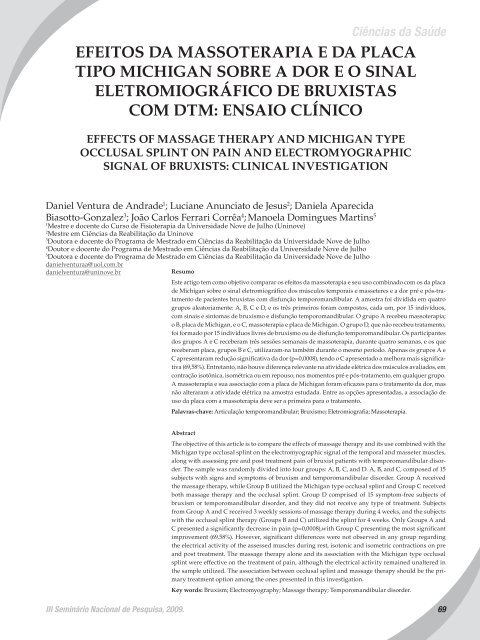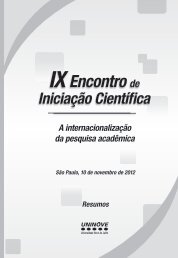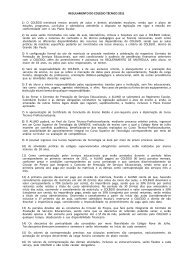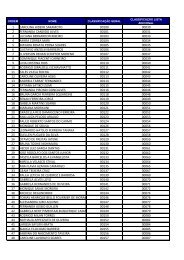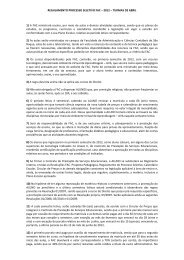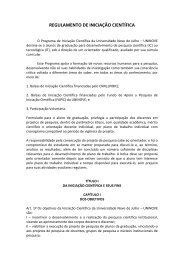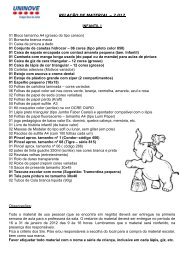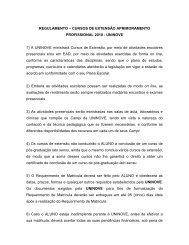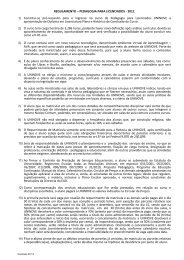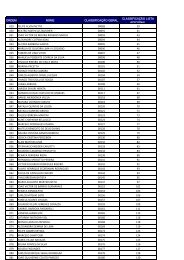Ciências da SaúdeSilveira Júnior P.C.S, Martins R.C.A, Dantas FHM.: Osefeitos da atividade física na prevenção da hipertensão.Rev. Bras. Med Esporte. Rio de Janeiro, v.5, n. 2, p. 56-72,1999.Alves, V. S. Um modelo de educação em saúde para oprograma saúde da família: pela integralidade da atençãoe reorientação do modelo assistencial. Interface , Botucatu,v.9, n.16, p.39-52, 2005. Disponível em: http://www.sciello.br/sciello. Acesso em: 22 jun. 2008.Nunes, et al. O agente comunitário de saúde: construçãoda identidade desse personagem híbrido e polifônico.Cad. Saúde Pública, Rio de Janeiro, v.18, n.6, p. 1639-1646,2002, Disponível em: .Acesso em: 22 jun. 2008.Cavalcante, et al. Análise de implementação das áreasestratégicas da atenção básica nas equipes de saúde dafamília em município de uma região metropolitana donordeste brasileiro. Rev. Bras. Saúde Mater. Infant. Recife,v.6, n.4,p.437-445, 2006. Disponível em: http://www.sciello.br/sciello. Acesso em: 22 jun. 2008.Bezerra, A. F. B.; Espirito Santo, A. C.; Batista Filho, M.Concepções e práticas do agente comunitário na atençãoà saúde do idoso. Rev. Saúde Pública, São Paulo, v. 39, n. 5,p. 809-815, 2005. Disponível em: http:// www.sciello.br/sciello. Acesso em: 22 jun. 2007.Buchabqui, J. A.; Capp, E.; Petuto, D. R. S.; Convivendocom agentes de transformação: a interdisciplinaridadeno processo de ensino/aprendizado em saúde. Rev.bras. educ. med., Rio de Janeiro, v. 30, n. 1, p. 32-38, 2006.Disponível em: http://www.sciello.br/sciello. Acessoem: 22 jun. 2008.Prefeitura SP - S M S – Protrahi -2007. Disponível em:http://wwwsms.saude.gov.br/.pdf. Acesso em: 1º set. 2008.Porth,CM. et al. Fisiopatologia. Rio de Janeiro: 6. ed., cp.23,p. 445-456, Guanabara Koogan; 2004.68III Seminário Nacional de Pesquisa, 2009.
Ciências da SaúdeEFEITOS DA MASSOTERAPIA E DA PLACATIPO MICHIGAN SOBRE A DOR E O SINALELETROMIOGRÁFICO DE BRUXISTASCOM DTM: ENSAIO CLÍNICOEFFECTS OF MASSAGE THERAPY AND MICHIGAN TYPEOCCLUSAL SPLINT ON PAIN AND ELECTROMYOGRAPHICSIGNAL OF BRUXISTS: CLINICAL INVESTIGATIONDaniel Ventura de Andrade 1 ; Luciane Anunciato de Jesus 2 ; Daniela AparecidaBiasotto-Gonzalez 3 ; João Carlos Ferrari Corrêa 4 ; Manoela Domingues Martins 51Mestre e docente do Curso de Fisioterapia da Universidade Nove de Julho (<strong>Uninove</strong>)2Mestre em Ciências da Reabilitação da <strong>Uninove</strong>3Doutora e docente do Programa de Mestrado em Ciências da Reabilitação da Universidade Nove de Julho4Doutor e docente do Programa de Mestrado em Ciências da Reabilitação da Universidade Nove de Julho5Doutora e docente do Programa de Mestrado em Ciências da Reabilitação da Universidade Nove de Julhodanielventuraa@uol.com.brdanielventura@uninove.brResumoEste artigo tem como objetivo comparar os efeitos da massoterapia e seu uso combinado com os da placade Michigan sobre o sinal eletromiográfico dos músculos temporais e masseteres e a dor pré e pós-tratamentode pacientes bruxistas com disfunção temporomandibular. A amostra foi dividida em quatrogrupos aleatoriamente: A, B, C e D, e os três primeiros foram compostos, cada um, por 15 indivíduos,com sinais e sintomas de bruxismo e disfunção temporomandibular. O grupo A recebeu massoterapia;o B, placa de Michigan, e o C, massoterapia e placa de Michigan. O grupo D, que não recebeu tratamento,foi formado por 15 indivíduos livres de bruxismo ou de disfunção temporomandibular. Os participantesdos grupos A e C receberam três sessões semanais de massoterapia, durante quatro semanas, e os quereceberam placa, grupos B e C, utilizaram-na também durante o mesmo período. Apenas os grupos A eC apresentaram redução significativa da dor (p=0,0008), tendo o C apresentado a melhora mais significativa(69,58%). Entretanto, não houve diferença relevante na atividade elétrica dos músculos avaliados, emcontração isotônica, isométrica ou em repouso, nos momentos pré e pós-tratamento, em qualquer grupo.A massoterapia e sua associação com a placa de Michigan foram eficazes para o tratamento da dor, masnão alteraram a atividade elétrica na amostra estudada. Entre as opções apresentadas, a associação deuso da placa com a massoterapia deve ser a primeira para o tratamento.Palavras-chave: Articulação temporomandibular; Bruxismo; Eletromiografia; Massoterapia.AbstractThe objective of this article is to compare the effects of massage therapy and its use combined with theMichigan type occlusal splint on the electromyographic signal of the temporal and masseter muscles,along with assessing pre and post treatment pain of bruxist patients with temporomandibular disorder.The sample was randomly divided into four groups: A, B, C, and D. A, B, and C, composed of 15subjects with signs and symptoms of bruxism and temporomandibular disorder. Group A receivedthe massage therapy, while Group B utilized the Michigan type occlusal splint and Group C receivedboth massage therapy and the occlusal splint. Group D comprised of 15 symptom-free subjects ofbruxism or temporomandibular disorder, and they did not receive any type of treatment. Subjectsfrom Group A and C received 3 weekly sessions of massage therapy during 4 weeks, and the subjectswith the occlusal splint therapy (Groups B and C) utilized the splint for 4 weeks. Only Groups A andC presented a significantly decrease in pain (p=0,0008),with Group C presenting the most significantimprovement (69.58%). However, significant differences were not observed in any group regardingthe electrical activity of the assessed muscles during rest, isotonic and isometric contractions on preand post treatment. The massage therapy alone and its association with the Michigan type occlusalsplint were effective on the treatment of pain, although the electrical activity remained unaltered inthe sample utilized. The association between occlusal splint and massage therapy should be the primarytreatment option among the ones presented in this investigation.Key words: Bruxism; Electromyography; Massage therapy; Temporomandibular disorder.III Seminário Nacional de Pesquisa, 2009. 69
- Page 1 and 2:
ASPECTOS AMBIENTAIS EM PESQUEIRO(PE
- Page 3 and 4:
Ciências Biologicas(WATTENDORF, 19
- Page 5 and 6:
Ciências BiologicasFigura 2: Fotog
- Page 7 and 8:
Ciências BiologicasFigura 5: Fotog
- Page 9 and 10:
Ciências BiologicasNo lago 4, sua
- Page 11 and 12:
Ciências BiologicasFigura 12: Foto
- Page 13 and 14:
Ciências BiologicasFigura 16: Foto
- Page 15 and 16:
Ciências BiologicasFigura 20: Foto
- Page 17 and 18: Ciências BiologicasELER, M. N. et
- Page 19 and 20: Ciências da SaúdeSINTOMAS DE DIST
- Page 21 and 22: Ciências da Saúdemeses, e se est
- Page 23: A prevenção é a melhor medida pa
- Page 26 and 27: Ciências da Saúde261 Introdução
- Page 28 and 29: Ciências da SaúdeFigura 2: coloca
- Page 30 and 31: Ciências da SaúdeLEE, G.; POLLO,
- Page 32 and 33: Ciências da Saúde321 Introdução
- Page 34 and 35: Ciências da Saúdee amplie o seu
- Page 37 and 38: Ciências da SaúdeCONHECIMENTO DOS
- Page 39 and 40: Ciências da SaúdeA maioria das ú
- Page 41 and 42: Ciências da SaúdeQuando questiona
- Page 43 and 44: Ciências da Saúdeé raro observar
- Page 45 and 46: Ciências da SaúdeGráfico 1: Dist
- Page 47: Ciências da SaúdeBorges, EL. Trat
- Page 50 and 51: Ciências da Saúde50IntroduçãoAs
- Page 52 and 53: Ciências da Saúde52Instrumentos d
- Page 54: Ciências da SaúdeBU para fins de
- Page 57 and 58: ConclusãoForam entrevistados 11 (5
- Page 59 and 60: Ciências da SaúdeHIPERTENSÃO ART
- Page 61 and 62: Ciências da SaúdeÉ inegável que
- Page 63 and 64: A idade dos usuários varia de 30 a
- Page 65 and 66: Ciências da Saúdecomo terapia ini
- Page 67: 27%Conclusão7% 4% 1%Pressão Arter
- Page 71 and 72: Ciências da SaúdeEsclarecido e fo
- Page 73 and 74: Ciências da Saúde6050Dor em mm403
- Page 75 and 76: azão da falta de evidências. McNe
- Page 77: 45. Armijo-Olivo S, Gadotti I , Kor
- Page 80 and 81: Ciências Exatas e da Terra801 Intr
- Page 82 and 83: Ciências Exatas e da Terraidentida
- Page 84 and 85: Ciências Exatas e da TerraInvestig
- Page 86 and 87: Ciências Exatas e da TerraFigura 3
- Page 88 and 89: Ciências Exatas e da TerraExtraç
- Page 90 and 91: Ciências Exatas e da Terraselecion
- Page 93 and 94: A PROPOSTA CURRICULAR DOPROGRAMA
- Page 95 and 96: Ciências Humanasapoiar o professor
- Page 97 and 98: Ciências HumanasO programa “São
- Page 99: e de sua aplicação em diferentes
- Page 103 and 104: Ciências Humanasdebates no Congres
- Page 105 and 106: Ciências Humanaspolítica de conte
- Page 107 and 108: cas até os recursos humanos. De ac
- Page 111 and 112: A RELIGIOSIDADE NO FUTEBOL PROFISSI
- Page 113 and 114: mas questões: Serginho tinha condi
- Page 115 and 116: Ciências Humanasquisa, era uma equ
- Page 117 and 118: Ciências Humanasameaçados de exti
- Page 119 and 120:
ALFABETIZAÇÃO: ONDE E COMO SE FOR
- Page 121 and 122:
político, ela deve ser vivenciada
- Page 123 and 124:
4 Política nacional de formaçãoi
- Page 125:
Ciências HumanasDessa forma, acred
- Page 128 and 129:
Ciências Humanas1 IntroduçãoEste
- Page 130 and 131:
Ciências HumanasO aprender a ser e
- Page 133 and 134:
COMPLEXIDADE NA INTEGRAÇÃODO OPER
- Page 135 and 136:
Ciências Humanassua principal fun
- Page 137 and 138:
Ciências Humanasrias da Logística
- Page 139 and 140:
Ciências HumanasNível de Qualidad
- Page 141 and 142:
Ciências Humanasno nível de servi
- Page 143 and 144:
objetivos estratégicos da empresa
- Page 145 and 146:
Ciências HumanasEDUCAÇÃO, PROTES
- Page 147 and 148:
Ciências Humanaso resultado de 105
- Page 149 and 150:
que a dialética do real é impregn
- Page 151 and 152:
Ciências HumanasINVENTÁRIO CRÍTI
- Page 153:
Ciências Humanasnão é nada despr
- Page 169 and 170:
MÚSICA BRASILEIRA PARAENSINAR GEOG
- Page 179 and 180:
Ciências HumanasPRÁTICA DOCENTE E
- Page 183:
de importância e as relações int
- Page 189:
A região manteve suas característ
- Page 209:
Ciências Sociais AplicadasESTUDO D
- Page 229 and 230:
Ciências Sociais AplicadasHIDROGRA
- Page 234 and 235:
Ciências Sociais AplicadasFigura 1
- Page 237 and 238:
3.3 Orientação de vertentesA orie
- Page 239:
______.; SAD, J. H. G. Estratigrafi
- Page 252:
Ciências Sociais AplicadasIntrodu
- Page 260:
Ciências Sociais Aplicadas1 Introd
- Page 271 and 272:
SOLOS DO PARQUE ESTADUALDO IBITIPOC
- Page 274 and 275:
Ciências Sociais AplicadasFigura 1
- Page 276 and 277:
Ciências Sociais AplicadasAnálise
- Page 281:
Ciências Sociais AplicadasAnálise
- Page 287 and 288:
ENSINANDO E APRENDENDOA CULTURA DA
- Page 291 and 292:
Engenhariascias seja suficiente par
- Page 293 and 294:
EngenhariasEm seguida, como em outr
- Page 295 and 296:
EngenhariasA sequência a seguir re
- Page 297:
LEMKE, J. L. Articulating communiti
- Page 300 and 301:
Engenharias1 IntroduçãoDestro 1 p
- Page 302 and 303:
Engenhariasvisando à racionalizaç
- Page 304:
EngenhariasComo se trata de usinage
- Page 308 and 309:
EngenhariasIntroduçãoNeste trabal
- Page 310 and 311:
Engenharias2.3 Soluções sólitons
- Page 313 and 314:
Linguística Letras e ArtesLINGUAGE
- Page 315:
Linguística Letras e ArtesBABINI,
- Page 318 and 319:
Linguística Letras e Artes1 Consid
- Page 320 and 321:
Linguística Letras e ArtesTexto 2
- Page 322 and 323:
Linguística Letras e Artesaquilo q
- Page 324 and 325:
Linguística Letras e Artes1 Introd
- Page 326 and 327:
Linguística Letras e Artesela ser
- Page 328 and 329:
Linguística Letras e Artescujos tr
- Page 330 and 331:
Linguística Letras e Artes1 Introd
- Page 332 and 333:
Linguística Letras e ArtesLÍGIA
- Page 335 and 336:
Linguística Letras e ArtesPEDAGOGI
- Page 337 and 338:
Linguística Letras e Artessem que
- Page 339:
ReferênciasANDRÉ, M. E. D. A. de:


